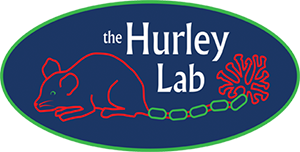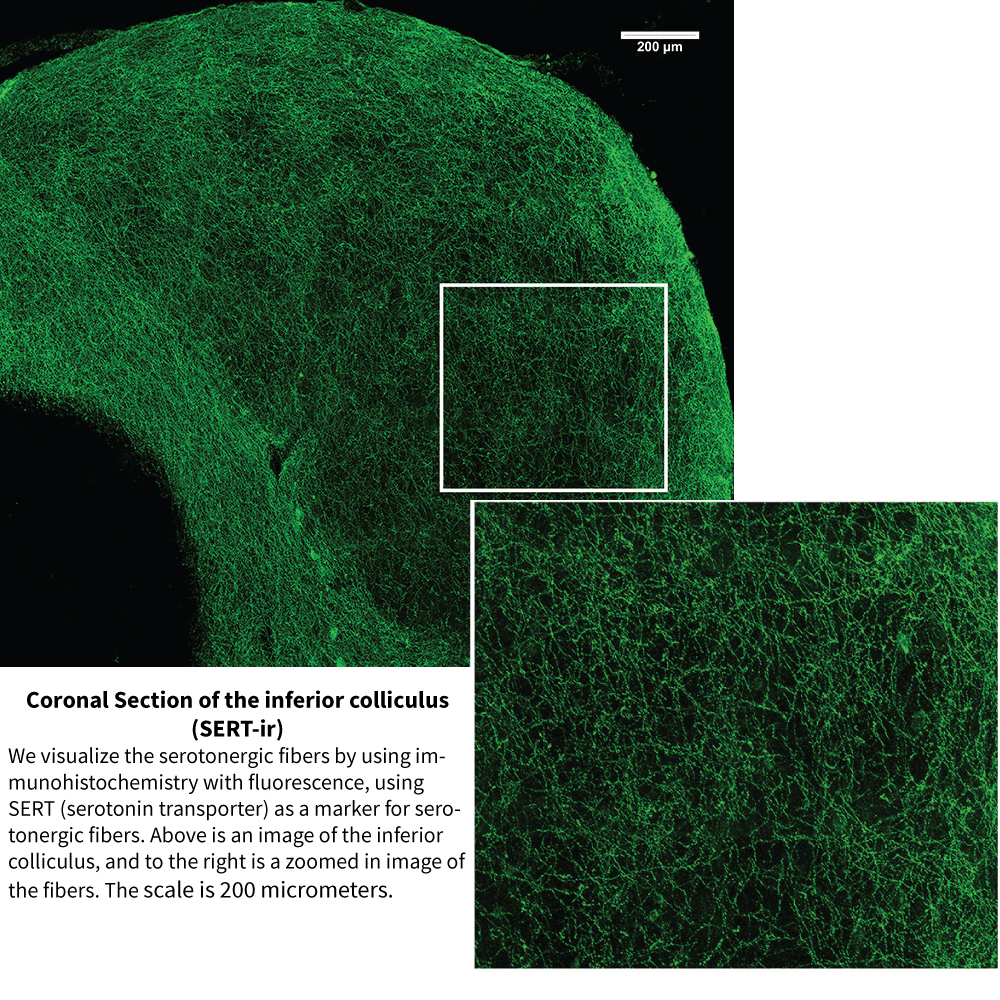
Research

Prolonged social isolation and deprivation have shown to have dramatic neurological and behavioral effects in rodents. At a behavioral level, isolated rodents become more aggressive towards intruders than socially housed rodents, and at a neural level, serotonin is influenced by social isolation, such that both structure and function affected, specifically at the level of serotonergic release, receptors, and fiber density. The goal of these experiments is to investigate the structural differences between two groups of mice in the serotonergic system of the inferior colliculus, an area that potentially links social context and auditory processing using serotonin.
In this study, we are investigating whether groups of socially housed mice differ in serotonergic fiber density from socially isolated mice. We are carrying out two different experiments: one with just males, assessing dominance status within the socially housed groups, and one with just females, assessing both dominance status within the socially housed groups and estrus state between both groups of females. We predict, that structurally, socially housed mice will have higher serotonergic fiber density counts within the inferior colliculus than socially isolated mice. We will carry out these experiments using immunohistochemistry and fluorescent microscopy to stain and image the serotonin transporter within this brain region, a useful marker for serotonergic fibers.

For animals that use vocal communication, the auditory system is essential for determining appropriate behavior in a social context. Many different factors such as the nature of external events, internal emotional state, or feedback from social partners can influence the interpretation of vocal communication signals. In fact, this is a 2-way street, with sensory systems, including the auditory system, providing much of the information used to make decisions about the most appropriate responses to communication signals.
A major goal in our lab is to understand how the features of social context are conveyed to the auditory system. To this end, we study a major neuromodulatory system in the brain that is involved in regulating important states like mood and appetite: the serotonergic system. The centralized serotonergic system is not part of the auditory system, and its involvement in regulating social behavior puts it in an excellent position to communicate social information through its projections to the auditory system. The overarching model that we use is that the serotonergic system is one output of social behavior networks, which assess the social milieu and feed back to sensory systems, thus calibrating sensory input to particular social contexts.
The presence of a feedback system also raises the possibility that poorly regulated contextual feedback could contribute to communication disorders.
Vocal communication depends on context:
The vocalizations that house mice produce to communicate with each other have been studied for decades, but continue to present the opportunity for new discoveries. Mice do not learn to produce song in the same way that songbirds do, but the production and reception of vocalizations are highly sensitive to different aspects of context. The nature of external events, the identities of social partners, internal state, and past experience can all influence vocalization structure, as well as behavioral or physiological responses to vocalizations.
Vocal signals of mice:
Many recent discoveries about mouse vocalization, including some within our lab, have focused on the ultrasonic vocalizations (USVs) produced by male mice as they court females. We have found that the ways that male mice use different classes of USVs, as well as the structure of vocalizations within classes, are responsive to important features of context such as whether females are in receptive reproductive stages. More recently, we have explored audible vocalizations (squeaks) produced most commonly by female mice during courtship. These are the general type of mouse call that is most commonly encountered by human listeners, since both female and male mice produce squeaks when in distress. Squeaks are also the mouse call type about which arguably the least is known. Females produce squeaks while they are rejecting males during the early phases of courtship, and high numbers of squeaks early on are associated with lower levels of later sexual behavior. Females also produce squeaks in later stages of courtship during male mounting, however, so the functional relationship of squeaks to behavior may be nuanced. We have further found that the acoustic structure of squeaks corresponds to female reproductive state, and to the identities of individual females. Explore our ‘mouse call library’ link to hear slowed-down versions of both male USVs and female squeaks.
Vocal reception:
We are currently working to develop behavioral assays for male responses to female vocalizations during courtship- stay tuned.
Modulation of auditory processing is context-dependent:
We have found that as mice interact with each other, serotonin levels rise within the inferior colliculus, an important region for processing vocalization in the auditory midbrain. The inferior colliculus is a mammalian brain structure, but has homologues in other vertebrate groups. Serotonin not only increases in the IC during social interaction, but also encodes social valence, or the salience of a social interaction from a particular individual’s perspective. In male mice interacting with females, serotonin levels do not increase much when males are being rejected by their female social partners, and increase most when rejection by females is low.
After serotonin is released, we have found that it has the ability to dramatically change the ways that single auditory neurons respond to sound, including vocalizations, through a wide range of different serotonin receptor types. Different receptors have divergent effects on the responses of the neurons to sound, creating a high degree of potential flexibility in the effects of serotonin. In general, serotonin makes auditory neurons more selective for the types of stimuli that evoke responses.
A recent study from our lab has suggested that at a population level, serotonin emphasizes responses to stimuli in socially salient contexts. This study used an antibody for an immediate early gene product, c-Fos, to label neurons in the IC of female mice following social and nonsocial situations, while either augmenting or depleting serotonin levels. In the presence of high levels of serotonin, more IC neurons showed c-Fos activation following social contexts than non-social contexts. Further, the effects of augmenting and decreasing serotonin levels depended on the reproductive states of the females. These results suggest that not only the release of serotonin, but also the responses of auditory neurons to serotonin, are highly sensitive to important features of context, including both the nature of external events and internal state.
Plasticity in serotonin-auditory interactions: trauma and isolation
Hearing loss
Damage to the auditory system can induce plasticity in interactions between the serotonergic and auditory systems in conjunction with hearing loss. We use a combination of molecular genetic techniques, cell staining, and single-cell physiology to investigate how damage to hearing through exposure to loud noise can influence the way sounds are processed by the brain.
A study from our lab using an antibody to the serotonin transporter demonstrated that auditory damage changes the structure of serotonergic inputs to the inferior colliculus. When only one ear was damaged by loud noise, serotonin-producing fibers showed an imbalance between colliculi on the two different sides of the brain. More recently, we’ve found that hearing damage may also alter events downstream of serotonin release, by changing the expression of serotonin receptors. Auditory damage selectively alters the expression of two serotonin receptors in particular: the genes encoding the 5-HT1B and 5-HT1A receptors are upregulated following auditory damage.
Early life social isolation
Social experience in early life has a profound effect on social behaviors including vocal communication, and also on the serotonergic system. We are currently exploring whether early social experience can influence serotonergic infrastructure, the context dependence of serotonin release, or the responses of IC neurons to manipulation of serotonin.